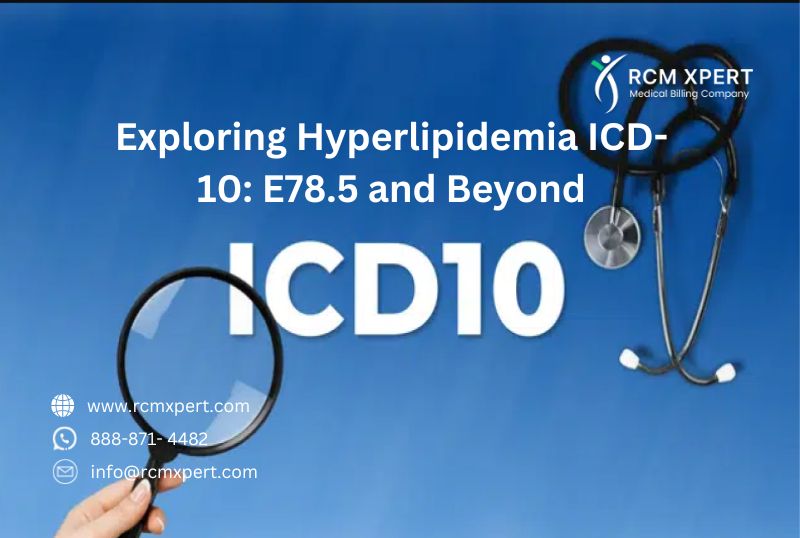Hyperlipidemia is a common condition that affects millions of people worldwide. But what exactly is it, and why should we care about its ICD-10 code? In this comprehensive guide, we’ll dive deep into hyperlipidemia, its diagnosis, and the importance of proper coding in healthcare. So, let’s embark on this lipid-filled journey together!
What is Hyperlipidemia?
Before we jump into the coding world, let’s break down what hyperlipidemia actually means.
The Lipid Lowdown
Hyperlipidemia is a fancy term for having too many lipids (fats) in your blood. These lipids include:
- Cholesterol
- Triglycerides
When these levels get too high, it can spell trouble for your health.
Types of Hyperlipidemia
There are two main types of hyperlipidemia:
- Primary hyperlipidemia: This type is caused by genetic factors.
- Secondary hyperlipidemia: This type is caused by other underlying conditions or lifestyle factors.
Understanding ICD-10 Codes
Now that we’ve got the basics down, let’s talk about ICD-10 codes. What are they, and why do they matter?
What is ICD-10?
ICD-10 stands for International Classification of Diseases, 10th Revision. It’s a coding system used by healthcare providers to classify and code all diagnoses, symptoms, and procedures.
Why are ICD-10 Codes Important?
ICD-10 codes are crucial for several reasons:
- Accurate billing: They ensure that healthcare providers bill correctly for services.
- Statistical analysis: These codes help track disease prevalence and trends.
- Research: They facilitate medical research by standardizing diagnoses across different healthcare systems.
Hyperlipidemia ICD-10: E78.5 and Related Codes
Let’s dive into the specific ICD-10 code for hyperlipidemia and some related codes.
E78.5: The Primary Code for Hyperlipidemia
The main ICD-10 code for hyperlipidemia is E78.5. This code is used for:
● Unspecified hyperlipidemia
● Mixed hyperlipidemia
Related ICD-10 Codes
While E78.5 is the primary code, there are several related codes that healthcare providers might use:
- E78.0: Pure hypercholesterolemia
- E78.1: Pure hypertriglyceridemia
- E78.2: Mixed hyperlipidemia
- E78.3: Hyperchylomicronemia
- E78.4: Other hyperlipidemia
Diagnosing Hyperlipidemia
Now that we understand the coding, let’s look at how hyperlipidemia is diagnosed.
Lipid Panel: The Key to Diagnosis
The primary tool for diagnosing hyperlipidemia is a lipid panel. This blood test measures:
- Total cholesterol
- LDL cholesterol (the “bad” cholesterol)
- HDL cholesterol (the “good” cholesterol)
- Triglycerides
Interpreting Lipid Panel Results
Here’s a quick guide to interpreting lipid panel results:
● Total cholesterol: Less than 200 mg/dL is desirable
● LDL cholesterol: Less than 100 mg/dL is optimal
● HDL cholesterol: 60 mg/dL or higher is protective against heart disease
● Triglycerides: Less than 150 mg/dL is normal
If these numbers are higher than the recommended levels, a diagnosis of hyperlipidemia may be made.
Treatment Options for Hyperlipidemia
Once diagnosed, what can be done about hyperlipidemia? Let’s explore some treatment options.
Lifestyle Changes: The First Line of Defense
For many people, lifestyle changes can make a big difference:
- Diet: Reducing saturated fats and increasing fiber intake
- Exercise: Regular physical activity can help lower lipid levels
- Weight management: Losing excess weight can improve lipid profiles
- Quitting smoking: Smoking cessation can help improve HDL levels
Medications: When Lifestyle Changes Aren’t Enough
If lifestyle changes don’t sufficiently lower lipid levels, medications may be prescribed:
- Statins: These are the most commonly prescribed medications for hyperlipidemia
- Fibrates: These primarily lower triglyceride levels
- Bile acid sequestrants: These help remove cholesterol from the body
- Niacin: This vitamin can help lower LDL and raise HDL
- PCSK9 inhibitors: These are newer drugs used for people with very high LDL levels
Complications of Untreated Hyperlipidemia
Why is it so important to diagnose and treat hyperlipidemia? Let’s look at some potential complications.
Cardiovascular Disease: The Big Risk
The primary concern with hyperlipidemia is its link to cardiovascular disease. High lipid levels can lead to:
- Atherosclerosis: Buildup of plaque in the arteries
- Heart attack: When blood flow to the heart is blocked
- Stroke: When blood flow to the brain is interrupted
- Peripheral artery disease: Reduced blood flow to the limbs
Other Potential Complications
While cardiovascular disease is the main concern, hyperlipidemia can also contribute to:
- Pancreatitis: Especially in cases of very high triglycerides
- Fatty liver disease: Accumulation of fat in the liver
Prevention: Keeping Hyperlipidemia at Bay
As with many health conditions, prevention is key. Here are some strategies to help prevent hyperlipidemia:
- Eat a heart-healthy diet: Focus on fruits, vegetables, whole grains, and lean proteins
- Stay active: Aim for at least 150 minutes of moderate-intensity exercise per week
- Maintain a healthy weight: Keep your BMI in the healthy range
- Limit alcohol consumption: Excessive alcohol can raise triglyceride levels
- Don’t smoke: If you do smoke, consider quitting
The Future of Hyperlipidemia Treatment and Coding
As medical science advances, so does our understanding and treatment of hyperlipidemia.
Emerging Treatments
Researchers are constantly working on new treatments for hyperlipidemia. Some exciting areas of research include:
- Gene therapy: Targeting the genes responsible for lipid metabolism
- RNA interference: Using small RNA molecules to “silence” genes that contribute to high lipid levels
- Microbiome manipulation: Exploring how gut bacteria influence lipid levels
The Evolution of Medical Coding
As our understanding of hyperlipidemia grows more nuanced, we may see changes in how it’s coded:
- More specific codes: Future versions of ICD may include more detailed codes for different types of hyperlipidemia
- Integration with genomic data: Codes may eventually incorporate genetic information related to lipid disorders
- AI-assisted coding: Artificial intelligence could help ensure more accurate and consistent coding
Conclusion: Navigating the World of Hyperlipidemia and ICD-10
Understanding hyperlipidemia and its ICD-10 code (E78.5) is crucial for both healthcare providers and patients. By recognizing the importance of proper diagnosis, coding, and treatment, we can better manage this common condition and reduce the risk of serious complications.
Remember, whether you’re a healthcare professional working with these codes or someone diagnosed with hyperlipidemia, knowledge is power. By staying informed about the latest developments in lipid management and medical coding, we can all contribute to better health outcomes.
So, the next time you hear “E78.5,” you’ll know it’s not just a random string of characters – it’s a key to understanding and managing hyperlipidemia. Here’s to healthy lipid levels and accurate coding!














